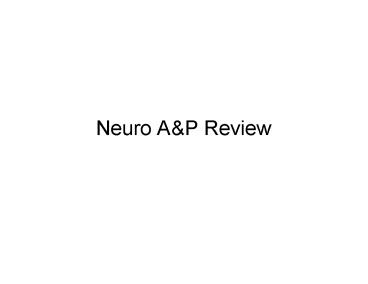Neuro A PowerPoint PPT Presentation
Title: Neuro A
1
Neuro AP Review
2
Nervous System
- CNS
- Brain
- Spinal cord
- PNS
- Cranial Nerves
- Spinal Nerves
- Afferent (sensory) pathways
- Efferent (effector/motor) pathways
3
Peripheral Nervous System
- Functionally
- Somatic system
- Autonomic system
- Sympathetic
- Parasympathetic
4
Nervous Tissue
- Neuron
- Supporting Cells
- Astrocytes (multiple roles)
- Oligodendria (form myelin in CNS)
- Schwann cells (form myelin in PNS)
- Microglia (CNS macrophage)
- Ependymal (lines ventricles forms CSF)
5
Neuron
6
(No Transcript)
7
Tracing the Neural Pathway
- http//www.pfizer.com/brain/dlgame.html
- Dendrite receives stimuli
- Initiates depolarization at cell body
- Electrical impulse jumps from node to node on
axon - At end of axon, reaches axon terminal
- Terminal releases neurotransmitters.
8
Initiation of Neural Impulse
- A single neuron may synapse with 50,000 other
neurons - Each secretes a neurotransmitter or neuropeptide
- Hundreds of possible chemicals
- Some excitatory
- Some inhibitory
- Varying strength
- Neuron must interpret this cacophony and
decide... - To depolarize or not to polarize... that is the
question
9
Nerve Injury and Regeneration
- Axon is severed
- Distal to injury
- Axon disintegrates
- Myelin sheath unwinds into Schwann cells and line
path - Proximal
- Disintegration to the next node of Ranvier
- Cell body swells
- Begins to grow from stump of axon down Schwann
path - Limited by scar tissue
10
Brain
- Cerebral cortex (rind) gray matter
- Frontal
- Parietal
- Temporal
- Occipital
- Wernickes area receptive aphasia
- Brocas area expressive aphasia
11
Brain
- Basal ganglia motor function
- Thalamus relay station
- Hypothalamus HR, BP, sleep, etc.
- Cerebellum motor coordination
- Brain stem
- Midbrain
- Pons
- Medulla respiration, heart, GI function, CN 8 -
12
12
Meninges
- 3 membranes surrounding brain and spinal cord
- Dura mater 2 layers
- Periosteum (next to cranium) (epidural space)
- Inner dura (meningeal layer)
- Subdural space between dura mater and next layer
- Arachnoid membrane
- Follows contours of brain but not sulci
- Subarachnoid space between arachnoid and next
layer - Pia Mater
- Delicate, follows sulci and fissures
13
CSF and Ventricles
- Similar to plasma
- Circulates in ventricles and subarachnoid space
(125 150 ml) at any one time - Brain floats in it
- Cushions against jarring and jolting
- Prevents pulling on meninges and blood vessels
14
Blood Supply
- Brain receives 20 of cardiac output
- Collateral circulation
- Internal carotid
- Vertebral arteries
- Join in circle of Willis
- Venous drainage
- Does not parallel arterial supply
- Venous plexuses and dural sinuses drain into
internal jugular vein
15
Neurotransmitters
- Multipurpose
- Depends on post-synaptic neuron and receptor type
- Acetylcholine multipurpose
- Crosses neuromuscular junction of motor neurons
- Released by both preganglionic sym parasympa
- Released by postganglionic parasympathetic fibers
- Cholinergic fibers
16
Neurotransmitters
- Norepinephrine
- Released by posganglionic sympathetic fibers
- Adrenergic fibers
- Released by adrenal glands
- Function of catecholamines varies by receptor and
tissue of receptor - a1 receptor most common
- a2 receptor cause inhibition/relaxation
- ß1 heart and kidney
- ß1 all other beta receptors
17
Functions of Autonomic System
- Generally
- Sympathetic stimulation promotes protection of
host - Increase BP, HR, glucose
- Increase muscle blood flow and stimulation
- Decrease renal flow and digestion
- Parasympathetic stimulation promotes rest,
tranquility and maintenance functions - Digestion
- Secretion of enzymes
- Action is often antagonistic
18
Aging
- Extremely complex
- How much is aging, and how much is disease?
- Brain
- Decreased weight and size
- Increased adherence of dura mater to skull
- Fibrosis of meninges
- Widened sulci
- Enlarged ventricles
19
Cellular Changes with Age
- Decrease in number of neurons
- Not consistent with cognitive loss
- Implications and reason are unknown
- Cellular changes
- Dendrite changes
- Lipofuscin deposition (Fatty deposits)
- Neurofibrillary tangles (abnormal proteins)
- Senile plaques (nerve degeneration)
- Last two are accelerated in Alzeimer's
- Changes is neurotransmitter function
20
Tests of Nervous Function
- X-ray primarily for bony structures
- CT 2-D recreation from multiple X-rays
- Structures, tumors, hemorrhage (with or without
contrast) - MRI magnetic field soft tissue analysis
- MRA (angiography) visualization of blood vessels
(stroke and TIA) - PET injection of radioactive substances detects
positrons indicates physiologic processes
21
Tests of Nervous Function
- Brain scan uptake of radioactive isotopes
- Cerebral angiography
- Myelography x-ray with subarachnoid dye
- Echoencephalography (ultrasound)
- Electroencephalography (EEG) seizures
- Evoked potentials
- CSF analysis protein, blood, organisms
22
Spinal Cord
- Nerve cell bodies arranged in horns
- Nerve pathways cross in the spinal cord
- Eg. Sensation of the left side of the body enters
the left dorsal horn, and crosses to the right
ventral horn and travels to right hemisphere - Sensation
- Spinothalamic tract pain, temperature, crude and
light touch - Posterior columms does not cross sides
position, vibration, finely localized touch

